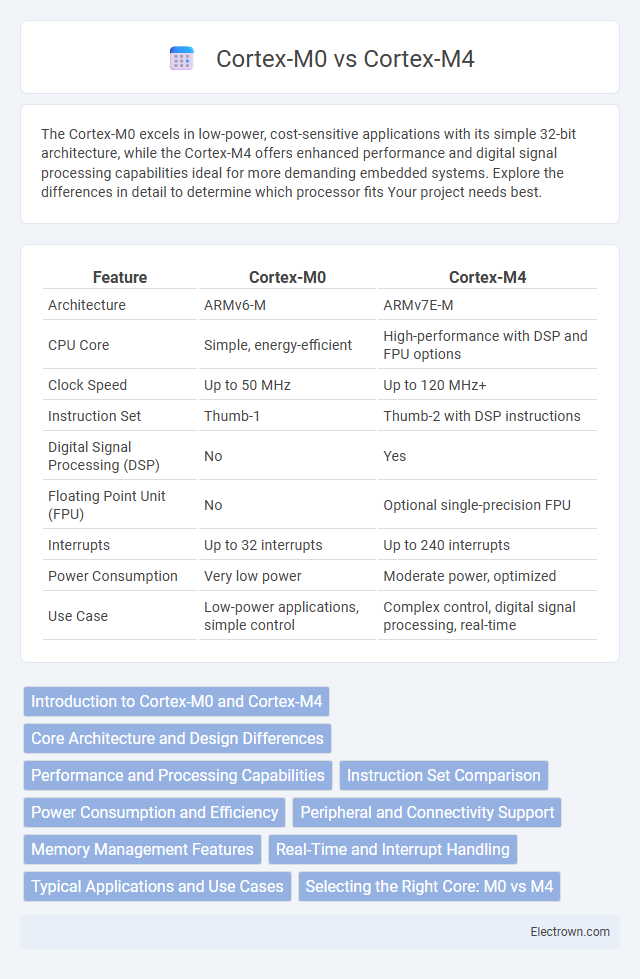The Cortex-M0 excels in low-power, cost-sensitive applications with its simple 32-bit architecture, while the Cortex-M4 offers enhanced performance and digital signal processing capabilities ideal for more demanding embedded systems. Explore the differences in detail to determine which processor fits Your project needs best.
Table of Comparison
| Feature | Cortex-M0 | Cortex-M4 |
|---|---|---|
| Architecture | ARMv6-M | ARMv7E-M |
| CPU Core | Simple, energy-efficient | High-performance with DSP and FPU options |
| Clock Speed | Up to 50 MHz | Up to 120 MHz+ |
| Instruction Set | Thumb-1 | Thumb-2 with DSP instructions |
| Digital Signal Processing (DSP) | No | Yes |
| Floating Point Unit (FPU) | No | Optional single-precision FPU |
| Interrupts | Up to 32 interrupts | Up to 240 interrupts |
| Power Consumption | Very low power | Moderate power, optimized |
| Use Case | Low-power applications, simple control | Complex control, digital signal processing, real-time |
Introduction to Cortex-M0 and Cortex-M4
Cortex-M0 is an energy-efficient, entry-level microcontroller core designed for low-power, cost-sensitive applications, featuring a 32-bit architecture with a simplified instruction set ideal for basic embedded systems. Cortex-M4 builds on this foundation by integrating a hardware floating-point unit (FPU) and digital signal processing (DSP) instructions, enabling enhanced performance for complex computation tasks in real-time control and audio processing. Both cores are part of the ARM Cortex-M family, optimized for deterministic interrupt handling and low-latency performance in embedded environments.
Core Architecture and Design Differences
The Cortex-M0 features a simpler, energy-efficient ARMv6-M architecture designed for basic embedded applications, while the Cortex-M4 uses the more advanced ARMv7E-M architecture, offering enhanced performance and digital signal processing capabilities. The M4 core includes a hardware floating-point unit and DSP instructions that the M0 lacks, enabling faster computation for complex tasks. You should choose Cortex-M0 for low power, cost-sensitive designs and Cortex-M4 for applications requiring higher processing power and real-time signal processing.
Performance and Processing Capabilities
Cortex-M4 offers significantly higher performance than Cortex-M0, featuring a 32-bit processor with DSP instructions and optional floating-point unit, enabling efficient handling of complex mathematical computations and real-time digital signal processing. Cortex-M0, designed for ultra-low power consumption and cost-sensitive applications, provides a simpler 32-bit ARMv6-M architecture suitable for basic control tasks and low-complexity processing. Your choice depends on the need for advanced processing capabilities and higher throughput in Cortex-M4 or energy-efficient, simpler operations in Cortex-M0.
Instruction Set Comparison
The Cortex-M0 uses the ARMv6-M instruction set with a simplified Thumb subset designed for low power and minimal code size, making it ideal for basic embedded applications. The Cortex-M4 supports the ARMv7E-M instruction set, which includes the full Thumb-2 instruction set along with DSP and optional floating-point instructions for enhanced signal processing and computational capabilities. This advanced instruction set enables the Cortex-M4 to perform more complex and high-performance tasks compared to the Cortex-M0.
Power Consumption and Efficiency
Cortex-M0 cores offer significantly lower power consumption, making them ideal for ultra-low-power applications and battery-operated devices. Cortex-M4 cores provide higher computational efficiency with enhanced performance and DSP capabilities but consume more power due to their increased processing complexity. Your choice depends on balancing energy efficiency needs against processing power requirements.
Peripheral and Connectivity Support
The Cortex-M4 core offers enhanced peripheral and connectivity support compared to the Cortex-M0, featuring advanced interfaces such as CAN, USB, and Ethernet, which are typically absent or limited in the Cortex-M0. While the Cortex-M0 supports essential peripherals for basic control tasks like timers, UART, and SPI, the Cortex-M4 includes additional communication protocols and hardware accelerators to facilitate more complex connectivity and real-time data processing. Your choice between these cores will depend on the complexity of peripheral integration and connectivity requirements in your embedded system design.
Memory Management Features
The Cortex-M0 features a simple memory management unit (MMU) designed for basic memory protection without virtual memory capabilities, supporting up to 4GB of linear address space primarily for embedded applications. In contrast, the Cortex-M4 includes a more advanced Memory Protection Unit (MPU) with configurable regions and access permissions, enabling finer control over memory access and security while lacking a full MMU. These differences make the Cortex-M4 better suited for applications requiring enhanced memory safety and isolation, such as real-time control systems with complex software stacks.
Real-Time and Interrupt Handling
The Cortex-M4 features a more advanced nested vectored interrupt controller (NVIC) compared to the Cortex-M0, enabling faster interrupt processing and better real-time performance for complex applications. Its higher clock speeds and DSP instructions improve responsiveness in time-critical tasks, making it suitable for sophisticated real-time control systems. Your choice between Cortex-M0 and Cortex-M4 will depend on the complexity and timing requirements of your interrupt-driven applications.
Typical Applications and Use Cases
Cortex-M0 processors are ideal for low-power, cost-sensitive applications such as simple IoT devices, wearables, and basic sensors where energy efficiency and compact code size are critical. Cortex-M4 cores excel in more complex embedded systems requiring digital signal processing (DSP) capabilities, including motor control, audio processing, and advanced sensor fusion, offering enhanced performance with floating-point support. Your choice depends on balancing application complexity, real-time processing needs, and power consumption constraints.
Selecting the Right Core: M0 vs M4
Selecting the right core between Cortex-M0 and Cortex-M4 depends on application requirements like processing power, energy efficiency, and real-time capabilities. The Cortex-M0 excels in ultra-low power consumption and cost-sensitive designs with simple control tasks, while the Cortex-M4 offers higher performance with digital signal processing (DSP) and floating-point unit (FPU) support for complex algorithms and audio processing. Evaluating factors such as interrupt latency, memory size, and peripheral compatibility ensures optimal core choice for embedded system designs.
Cortex-M0 vs Cortex-M4 Infographic

 electrown.com
electrown.com